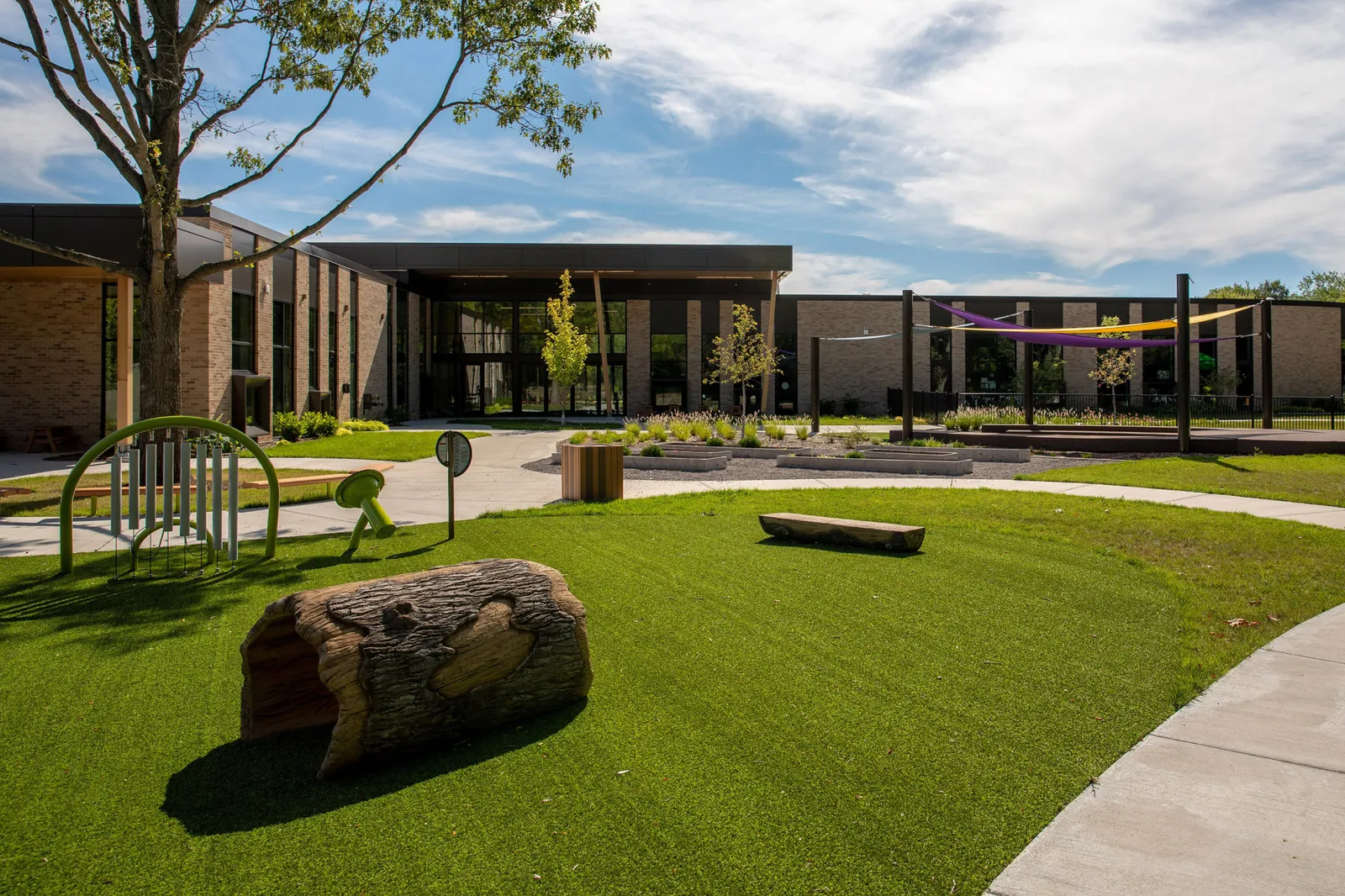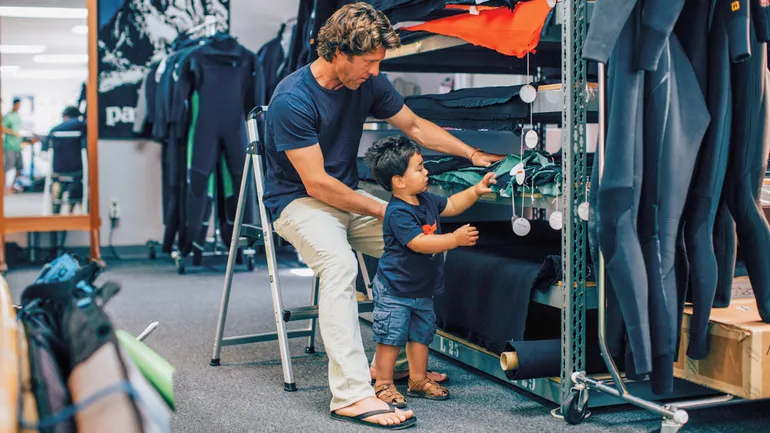This is the third installment of a five-part series on employers offering on-site day care.
Patagonia has always been as much a community fostering a company as a company fostering a community, so it stands to reason the company was early to the on-site day care game.
When the retailer was founded in 1973 by rock climber Yvon Chouinard, its first staff was a tight-knit group of climbers, surfers and skiers. Workers started getting married and having kids — and towing their little ones into the office. By 1983, Patagonia’s headquarters in Ventura, California, was becoming a bit raucous.
If the kids “were old enough, they were kind of running amok,” said Sheryl Shushan, director of global family services at the company. “If they were babies, they were sleeping in filing cabinets as bassinets. People were nursing in their cars if they had colicky babies.”
Chouinard’s wife, Malinda, ordered a trailer and hired an employee’s parent to watch the kids, but child care regulators eventually knocked on the door. So Patagonia dedicated some office space, acquired a license and hired a team of caregivers — giving birth to its on-site child care center, now in its 42nd year.
Making the investment
Patagonia’s child care is unique not only in its longevity, but also in its self-operation. Other employers who see a need for on-site child care don’t have to invent the program from the ground up.
“We had no intention of getting into the business of child care,” said Sara McLeod, director of global executive compensation at Whirlpool Corp. After establishing the need and getting leadership on board, the company put out a request for proposals and ended up selecting KinderCare, one of the national child care providers that partners with companies to develop and operate on-site centers.
KinderCare manages all day-to-day operations and hires the staff, McLeod said, leaving Whirlpool to focus on designing dishwashers rather than changing diapers. The company does provide input in certain areas, such as how much to charge employees and pay teachers.
Employers stress that on-site day care is an investment, not a revenue stream. Steamboat Ski & Resort Corp. subsidizes its child care center to the tune of $200,000 annually. Located in pricey Southern California, Patagonia “charges average market rates for high-quality child care,” with the company subsidizing the difference, Shushan said. Whirlpool uses a tiered approach to tuition and pays a premium to attract top caregivers in the area.
The reception area for Whirlpool’s child care center, The Eddy, during the center’s grand opening celebration. Whirlpool partners with national provider KinderCare to run its center.
Permission granted by Whirlpool
Filling in the gaps
While child care providers like Bright Horizons and KinderCare can help make the case and bring the expertise needed for start-up, other resources exist to help HR explore the possibility and, in some cases, secure financial backing to set the project in motion.
Steamboat Resort, for example, benefited from a Colorado grant program that helps employers build or retrofit a child care center near their place of operation. The resort obtained $500,000 through the grant, meaning it only needed to match $500,000 with their own funds to set up the center and open its doors. Steamboat is one of 26 employers across the state to receive a grant since the program began in 2022, with awards ranging from $150,000 to $800,000.
Steamboat also partnered with Denver-based Executives Partnering to Invest in Children. EPIC has worked with more than 40 employers to beef up family-friendly benefits. At the time Steamboat was pursuing its center, EPIC had just introduced a Design Lab to help employers understand all the components that go into on-site child care programs. Steamboat became part of the first class.
“They were instrumental in our implementing a child care center,” said Loryn Duke, director of communications at Steamboat. “The Design Lab offered everything from, you know, what are the rules and requirements in the state of Colorado? What federal support is there? What grant support is there? How do you get your sign-offs? Where do you purchase little mini toilets? We don’t know how to do that stuff.”
Working with EPIC was eye-opening for Duke in terms of the resources available for employers looking to bring child care on site.
“We are in a very competitive business. The information that we deal with is proprietary, but we’re finding that with child care, it’s not that way,” Duke said. “People have success stories, they have financials, they have how-to guides, and they want to share them, because they want other businesses to succeed.”
Across the country, a small patchwork of programs exists to support employers in making the leap. Maine in 2022 created a grant program open to employers to apply for funding and technical assistance to launch or grow child care centers. In January, Iowa awarded $14 million in grants to 13 employers across the state to build and expand child care centers.
Businesses can also take advantage of child care tax credits, which allow them to claim expenses related to child care operations and reduce corporate income tax liability. These are currently available in at least 17 states, according to the National Conference of State Legislatures.

An outdoor play area at Whirlpool’s child care center, The Eddy. Whirlpool uses a tiered approach to tuition to make it affordable for workers at all income levels.
Permission granted by Whirlpool
Drawing up the blueprint
Bright Horizons operates roughly 600 centers nationwide, about half of which are employer-sponsored, according to Priya Krishnan, chief transformation officer at the company. Employers have an important role to play in the current American system for child care, she said.
“We think of the parent as a stakeholder, the government as a stakeholder, and the employer as a stakeholder,” she said. “The parent is working somewhere, the employer absolutely wants them to come back, and the government gains from people being employed and contributing to the economy. But in the U.S., historically, the government’s not been actively involved.”
Employer partners provide Bright Horizons with the space, pay the utility bills and sometimes create the facilities — providing playground equipment, for example. Similar to KinderCare’s arrangement with Whirlpool, Bright Horizons operates centers, hires caregivers, enrolls families and executes the curriculum.
Hospitals, educational institutions and financial services firms are among Bright Horizons’ top clients, Krishnan said, although the provider serves a broad mix of organizations. “A knowledge worker use case is easier to justify … because retraining and rehiring costs are very high,” she said, but “it’s actually the really progressive organizations who then do it for their front-line and middle-rung use cases.”
Because child care costs are so high, it can be difficult for front-line workers to decide between paying tuition or dropping out of the workforce. Organizations that prioritize — and usually, more heavily subsidize — child care for their front-line and lower-income workers can better attract a more diverse workforce, especially women and women of color, Krishnan said.

A child climbs on a rock wall at Patagonia’s on-site child care center. Patagonia was among the first employers to offer on-site child care, pioneering the program in the early ‘80s.
Permission granted by Patagonia
Tailoring a center to a company’s needs
An organization doesn’t necessarily need to be large to consider on-site day care.
“We actually see some child care centers which are built for 10 children,” Krishnan said, noting that one hospital partner runs a small center to help retain and attract nursing staff, given the current nursing shortage. Centers also sometimes limit their offerings. “We might only run an infant classroom, or an infant and a toddler classroom,” she said. “We might not have a preschool program in a 10-child setup.”
That can keep costs within an organization’s budget, too. “Starting a child care center is not an inexpensive thing to do,” said Steamboat Resort’s Duke. “But for us, we found that we were able to open our doors for about $1 million.” That opening included four rooms — infants, toddlers, preschool and pre-K — with 35 slots.
When the center opened, Duke said, their employees didn’t have 35 children under the age of 5. So the company opened extra slots to the community, as availability allowed. “We were very candid with community members that they were required to re-enroll every year, whereas employees may not be, and that their space wasn’t guaranteed,” Duke said.
In contrast, Whirlpool, which enrolls about 150 children, and Patagonia, which enrolls around 200 children, both reserve day care use for employees only.
While the ebb and flow of turnover and hiring might present challenges, employers can build a runway by working with parents and parents-to-be in advance. “We know people who are pregnant and coming back … so we just do a lot of planning,” Shushan said. “And so far it’s worked.”
Visuals Editor Shaun Lucas contributed to this story.





Leave a Reply